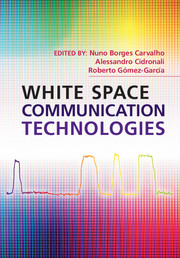Book contents
- Frontmatter
- Contents
- List of contributors
- Preface
- List of abbreviations
- Part I White space technology signal processing and digital design
- Part II Adaptable receivers for white space technologies
- 4 Reconfigurable RF front-ends for cognitive and software-defined radio
- 5 Filtering stages for white space cognitive/software-defined radio receivers
- 6 Subsampling multi-standard receiver design for cognitive radio systems
- Part III Adaptable transceivers for white space technologies
- Index
- References
4 - Reconfigurable RF front-ends for cognitive and software-defined radio
from Part II - Adaptable receivers for white space technologies
Published online by Cambridge University Press: 05 October 2014
- Frontmatter
- Contents
- List of contributors
- Preface
- List of abbreviations
- Part I White space technology signal processing and digital design
- Part II Adaptable receivers for white space technologies
- 4 Reconfigurable RF front-ends for cognitive and software-defined radio
- 5 Filtering stages for white space cognitive/software-defined radio receivers
- 6 Subsampling multi-standard receiver design for cognitive radio systems
- Part III Adaptable transceivers for white space technologies
- Index
- References
Summary
Introduction
Over the last decade, cognitive and software-defined radio (CSDR) systems have been presented as a potential solution to overcome problems that are encountered by the current multi-standard communication radios and also widely perceived spectral congestion hurdles. Note that spectral crowding and congestion problems are generally observed in certain frequency bands around metropolitan areas for certain periods of time while other bands may remain relatively unused or idle. This situation of unbalanced or nonuniformed spectral use may be remedied by the “cognitive” or “intelligent” function of radio systems. This is usually done through the receiver platform, even though the transmitter side may also be involved. There are two fundamental aspects or definitions to consider when talking about CSDR systems as illustrated in [1]. The first aspect is the software-defined radio (SDR), defined as a digital radio that can operate as: (a) a multi-band system that supports more than one frequency band, (b) a multi-standard system that supports more than one standard family (e.g., cellular systems, WLAN, WiMAX, IEEE802.11e), (c) a multi-service system that provides different services (e.g. voice, data, video streaming), and finally (d) a multi-channel system that supports two or more independent transmit and receive channels at the same time (e.g. frequency division duplex (FDD)). The second aspect is the cognitive radio (CR), defined as an SDR with capabilities to sense its electromagnetic spectral environment, and to track and react to changes and findings in a smart manner.
- Type
- Chapter
- Information
- White Space Communication Technologies , pp. 105 - 142Publisher: Cambridge University PressPrint publication year: 2014
References
- 1
- Cited by



